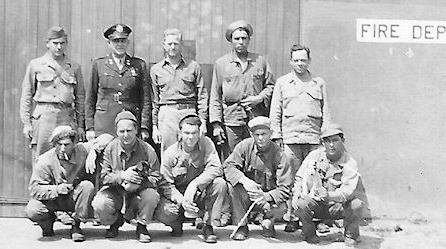

Unit History Initial Installment (dated 4 Dec 1944)
The 2101st Engineer Aviation Fire Fighting Platoon was activated in the European Theater of Operations at AAF Station 118 Wendling England on the 11th April 1944 by Section 1, General Orders No. 64, HQ, 2D Bombardment Division, dated 9 April 1944. The first commanding officer was Capt Albert E. Rossiter, who was assigned from the 10th Station Complement Squadron (SP). Capt Rossiter joined the organization on the 11th April 1944. The following enlisted men joined on the 11th April 1944:
Sgt Gregorio M. Reyna
Sgt Paul E. Turner
T/5 Kenneth L. Avery
Pfc John H. Back
Pfc Francis G. Clifford
Pfc Jack W. Pierce
Pfc Charles Sokolowski
Pvt Edmund J. Colucci
Pvt Lobel Schiff
(The above men were transferred from Detachment "A" 2033rd Engineer Aviation Fire Fighting Platoon.)
Sgts Reyna and Turner were assigned duties as section leaders. Pvt Schiff was made the unit clerk.
T/5 Jesse E. Minor
Pfc Robert W. Smith
(The above two men were transferred from Detachment "A" 806 Chemical Co.)
On the 14th April 1944, the following men were assigned from the 10th Station Complement Squadron:
Cpl Richard A. Holevoet
Cpl Leo E. Wand
Pfc Kenneth H. Kleckner
Pvt Alfredo Santora
Pvt Donald J. Williams
On the 15th April 1944, T/5 Jesse E. Minor was promoted to the grade of Sgt and PFC's Kenneth H. Kleckner and Robert W. Smith were promoted to the grade of Corporal. Pvts Alfredo Santora and Donald J. Williams were promoted to PFC.
On the 1st May 1944, Sgt Jesse E. Minor was promoted to the grade of S/Sgt and Cpl Robert W. Smith was promoted to the grade of Sgt.
S/Sgt Minor then assumed duties as fire chief. S/Sgt Minor had 2 years fire experience in the fire department of the Hercules Powder Co. at Roanoke, Virginia.
On the 4th June 1944, S/Sgt Minor was sent to London for 3 days to attend a demonstration of a new Air Ministry crash tender.
On the 14th June 1944, Sgt Robert W. Smith left for the RAF Station, Sutton-on-Hull, Yorkshire, for the purpose of attending the RAF NCO's Fire School. This course lasted for 4 weeks. It dealt with the construction of British apparatus and its use on fires. There was a considerable amount of fire apparatus drill.
On the 1st August 1944, Pvt Lobel Schiff was promoted to the grade of Cpl.
On the 10th August 1944, 1/Lt Lloyd A. Bimson joined from the 10th Station Complement Squadron.
Per Section 1, General Order 196, HQ, 2D Bombardment Division, dated 18 August 1944, the 2101st Engineer Aviation Fire Fighting Platoon was reorganized. Another fire fighting team was added which increased the strength 6 enlisted men. Sgt Robert W. Smith was put in charge of the added team. The following men were transferred into the organization on the 23rd August 1944 to bring it to strength:
Cpl Robert A. Hewitt
Pfc Jacob J. Riehl Jr.
Pfc Walter Szymkowicz
Pvt Frank J. Revetta
Pvt Andrew E. Saniski
Pvt Clayton H. Williams
(The above men were transferred from the 10th Station Complement Squadron.)
On the 30th August 1944, 1/Lt Lloyd A. Bimson was sent to RAF Station, Sutton-on-Hull, Yorkshire, for a period of two weeks to attend the "part time fire officers" school.
On the 1st September 1944, PFC John H. Back, Pfc Jacob J. Riehl Jr., and Pvt Edmund J. Colucci were promoted to the grade of T/5.
Capt Albert E. Rossiter was released from assignment to this organization and further assigned to the Casual Pool, Zone of the Interior, by letter, order, HQ, 8th AF, dated 9 Sept 1944 and departed from this organization on the 23rd September 1944. 1/Lt Lloyd A. Bimson assumed command of the organization.
PFC Donald J. Williams was transferred to the 1825th Ordnance S & M Co. on the 6th October 1944, and Pvt Frank M. Tilschneider was transferred from the 10th Station Complement Squadron to fill the vacancy on the 23rd October 1944.
During the month of October 1944, a series of drills was begun by the 3 teams of this organization with the fire apparatus. Drills were completed using the Coventry Climax trailer pump and the Sigmond trailer pump. The best time being 2½ minutes from the fire house to the WAAF Site, a distance of ½ mile, where the pump was set up and primed, and 50 feet of hose run out. This time was made by Sgt Reyna's crew.
PFC Walter Szymkowicz was promoted to the grade of T/5 on the 1st November 1944.
S/Sgt Jesse E. Minor was sent to AAF Station 121 for 7 days to attend a Cardox crash fire fighting school as the platoon will be equipped with this truck very shortly. The truck carries 3 tons of CO2 and is the latest equipment for airplane crash fires.
During the month of November, the drills with the equipment were carried on using the 1000 class trailer pump, the 135 crash fire truck, and the W.O.T.1 British fire tenders.
During November, a series of lectures was started to instruct the personnel of this station in the operation of fire extinguishers and types of fires they will be used on.
From the history of the 10th Station Complement Squadron for July 1944:
Part of the personnel of the 10th attended fire-fighting lectures put out by the Station Fire Marshall during the month and the entire squadron is to attend a demonstration on fire-fighting equipment and a lecture sometime in August. The men were instructed in the proper equipment etc to be used in extinguishing any type of fire that might possibly present itself. It is a good thing for the personnel of the squadron and all men attending the classes really appreciate what they are learning.
From the history of the 10th Station Complement Squadron for August 1944:
In the first week of August personnel of the 10th attended a lecture or fire show held on the station's ball field demonstrating how to use various types of fire extinguishers and foam, water and other expedients in putting out fires. It was very educational and interesting to see and all personnel received plenty of good out of this lecture. Perhaps some day it will save a good deal of money.
December 1944
S/Sgt Jesse E. Minor returned from one week Cardox School held at AAF Station 121 on the 3rd of December. On the 10th December, 1st Lt Lloyd A. Bimson went to AAF Station 121 to attend Cardox school for 3 days.
On the 17th December Sgt Robert W. Smith went to AAF Station 121 to attend Cardox School for a period of one week.
On the 20th December, S/Sgt Minor and T/5 Jacob G. Riehl Jr., went to AAF Station 158 [Sudbury, Derbyshire] to pick up the Cardox crash fire truck, Class 150, for this station. They got back on the 21st Dec.
The men have built a concrete standing for the CO2 storage tank in preparation for putting the Cardox equipment in operation. A training program has been started by S/Sgt Minor to acquaint the personnel with the operation and use of this equipment.
This month only one fire call was received, making this the best month of the year. There were no crash fires.
S/Sgt Minor continues to give lectures to personnel of the station on the use of first aid appliances and fire precautions.
January 1945
During January, this unit went on one domestic fire call and one crash fire call. A Nissen hut in Site 4 caught on fire and six men responded. The Class 135 crash fire truck and the Class 1000 trailer pump were used. The fire was extinguished in thirty minutes. Considerable damage was done to clothing and one end of the Nissen hut was burned out. The airplane crashed occurred on the Administrative Site and was without fire. However, the fire crew stood by while the Sub Depot was engaged in clearing the wreckage.
The exceptionally cold weather during the month caused a serious freezing problem and the personnel were kept very busy keeping the crash equipment thawed.
On the 26th of January, Sgt Gregorio M. Reyna and Cpl Richard A. Holevoet were transferred to the 12th Reinforcement Depot to undergo training as infantry reinforcements.
The Class 150 Cardox truck was placed in operation on the line for the first time on the 20th of January.
February 1945
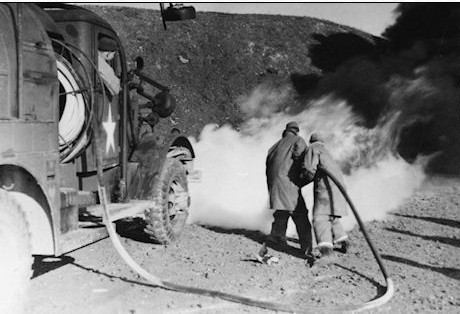

During the month of February, we had two drills with the Class 150 crash truck and the men handle the equipment very well. We found the side reels to be very clumsy and heavy to handle with the result that two men have to work them. We also carried out two hydrant drills using the small Sigmond trailer pump.
The section constructed a shed in which to park the trailer pumps. That is the final building project that we had in mind.
On the 1st of the month, Cpl Leo E. Wand was promoted to Sgt and Pvt Frank M. Tilschneider was promoted to Pfc.
We had one fire during the month. It occurred in the Aero Club snack bar and we were able to put it out with a 4 gallon pump type extinguisher. There was very little damage.
March 1945
On the 1st of March, Francis G. Clifford and Alfredo Santora were promoted from PFC to T/5.
On the 13th of March, T/5 Robert J. Saville was transferred into the unit as reinforcement, and later, on the 26th of March, PFC Frank M. Tilschneider was transferred to infantry training.
On the 20th of March, the airdrome was attacked by enemy aircraft who succeeded in starting a fire in some empty auxiliary petrol tanks. The fire crew under the direction of Sgt Turner went to the fire with the Class 150 Cardox and two foam trucks. They succeeded in extinguishing the flames in 15 minutes. Earlier in the month, the crash crew was called out to extinguish a fire in a truck on the perimeter track. This fire was knocked out in one minute by the Class 150 Cardox truck.
Difficulties were encountered with the foam appliances in the Cardox truck. It was found that the foam making solution had a tendency to settle out and clog the strainer at the foam pipe end of the line. This necessitates a thorough cleaning of all foam pipes and lines. The unit is now trying an American produced foam making compound. A British compound was used formerly.
Drills were continued throughout the month. Both crews drilled in the use of the 1000 trailer pump with the fog appliances and foam produced from the #10 branch pipes equipment. Several dry trailer pump drills were carried out against time. The crew led by Sgt Turner carried out a drill with the Class 135 fire truck. They practiced converting the equipment from water fog to foam.
The training of base personnel in the use of first aid fire appliances was continued.
Unit History, Final Installment (dated 15 April 1945)
On the 2d of April, Pfc James W. Allen was assigned to this unit as a limited assignment from the 70th Replacement Depot. On the 7th of April, PFC Albert F. Kunkel, another limited assignment, joined this unit, raising the total of limited assignments to 3.
T/5 Walter Szymkowicz was transferred on the 8th of April to Detachment "A" 1287th MP Co., this station.
On the 14th of April, the crash crew was dispatched to a fire near Gressenhall involving a crashed aircraft from this station. One member of the crew was carried away from the vicinity of the fire by Cpls Hewitt and Kleckner. [This was the crash of 2/Lt Charles W. Warner (578th Sqdn) aboard #42-50446. Seven of the eight men aboard died immediately; nose gunner S/Sgt Donald A. Kight was taken to a hospital where he died from his injuries on 29 May 1945.]
After being in existence for one year plus a few days, the 2101st Engineer Aviation Fire Fighting Platoon was disbanded on the 15th of April per Section 1, General Orders No. 52, HQ, 8th Air Force, dated 12 April 1945. All personnel, consisting of one officer and 21 enlisted men, were further assigned to the 403rd Headquarters & Base Services Squadron, Air Service Group, this station.
From the history of the HQ and Base Services Squadron, 403rd Air Service Group:
Also under the jurisdiction of the 403rd comes the ever-present fire department. These boys have it fairly soft most of the time but whenever there is a plane crash or fire they sure do earn their pay. They also earn their medals as proven the time a B-24, loaded with 500 pound bombs, caught fire and had to be hurriedly extinguished. Chief N.C.O. of the section is S/Sgt Minor with Sgt Turner as Base Crew leader. The following department is also composed of the following personnel: Sgt 'Tiny' Smith, Sgt Leo Wand, Cpls Avery, Hewitt, Santora, Saville, Kleckner, Colucci, Holevoet, Back, Riehl, Clifford and Sanske, with Pfc Kunkle finishing up the roster there. The boys also man the crash truck when needed. Suffice to say, they are doing their job well.
Additional information about the aircraft fire in the previous paragraph:
At about 2300 hours on 4 Dec. 1943, the 579th Sqdn was put on alert. At 0030 on 5 Dec, twelve 500-pound M43 demolition bombs were delivered to #556 in dispersal No. 41. They were placed in two areas under each wing. Sgt James D. Wyllie, Cpl Alvin Ottenstein, and another armorer then began installing the plane's ball turret guns.
After that, Cpl Ottenstein went to a/c 42-7529 in dispersal 41-A and got half a can of gas from M/Sgt Morris Golub. He re-fueled the Auxiliary Power Unit (APU, or putt-putt generator) for #556. Sgt Wyllie started the putt-putt and the men resumed getting #556 ready for its mission to Cognac.
At about 0130, the fuel tanks on the right side of #556 suddenly blew up. Bullets in the plane exploded; one tracer hit a fuel servicing unit which caught fire.
Cpl Allen Jacobs, fireguard for #529, ran towards #556. When he was about 50 feet away, he "met a man who was running from it and was on fire. I grabbed him and smothered the flames with my jacket. I then took him to a nearby hole full of water and completely extinguished his clothing." The man, Cpl Robert Shockley, had been in the left rear bomb bay when the fuel tanks exploded.
Three other men were also seen running from the plane, no doubt Sgt Wyllie and the armorers.
Flying Control personnel notified the Hospital and Group Operations and dispatched crash trucks. Men in the ordnance shop were told to go to the bomb shelter. 1/Lt Walter Giesecke had a nearby oil truck and both Cletracs (tractors) driven away.
A second explosion occurred at 0145. It ignited a gas trailer and an oil truck parked about 35 yards away in dispersal No. 43. Debris was scattered in all directions, damaging the a/c parked in dispersals 40 (#42-7510) and 41-A (#42-7529). Buildings and ground crew tents in the area were also damaged. A member of the crash crew tried unsuccessfully to move a/c 529; a pilot finally arrived who drove it to dispersal No. 43-A.
Another explosion followed at 0148.
Over the next half hour, the gas truck fire was put out and an effort was made to keep the other bombs from exploding. 1/Lt Brooks Pendleton had the Control Tower announce that all personnel should remain at least 2,000 yards from the fire. He then returned to the fire site and had the guards on duty move everyone farther back.
A few minutes later, at 0220, the fourth and final explosion occurred. Again, debris and fire were flung in all directions.
It was decided that the bombs should be moved from the adjacent a/c, #510; this was done by 1/Lt Wilbur Metz (Group Ordnance Officer) and T/Sgt James Switzer and Sgt Jack Truesdell of the 579th. As they worked, the fire near that dispersal was put out.
At 0730, crews aboard 21 a/c started engines; they began to taxi ten minutes later. As the first plane took off at 0756, ground support personnel were just minutes away from extinguishing all the fires.
When 1/Lt Giesecke inspected the two planes that had been nearest to #556, they both seemed "pretty badly damaged, having their fuselage warped and tail assemblies twisted." #510 didn't fly again until 20 Dec while #529's next mission was on 22 Dec.
Despite the fires and bomb detonations, only two men were injured. Sgt Wyllie sustained lacerations in his scalp and cheek and lost his left middle finger. Cpl Shockley suffered severe burns on his scalp and other parts of his body.
It was believed that the initial explosions were fuel tanks (first the right side, then the left side) while the other two explosions were from the eleven bombs under #556 that had detonated.
In his testimony, Cpl Ottenstein stated, "I put the fuel in the putt-putt, which was not running, and did not spill any." M/Sgt Glenn Engelhardt and M/Sgt Theodore Ritland also testified that they had been in and out of a/c 556 several times before the explosion; neither had detected any gas leak or smelled gas fumes.
The investigating board believed that when the putt-putt was refueled, some gas was probably spilled and then sparks from the APU ignited the fumes or fuel, causing the initial fire. It was recommended that all possible precautions be taken not to spill fuel when servicing the APU, and if fuel were spilled, "that power unit will not be operated until thoroughly dried and with fire extinguisher in hand."
Sgt Lee A. Doolittle was a member of the 392nd's crash crew. When #42-7556 caught fire in the early morning of 5 Dec 1943, his crew quickly arrived with tankers, foam makers, and other gear. The heat was so intense, though, they had no chance of putting the fire out right away. Instead, their main objective was to keep the planes nearby from being damaged.
When an adjacent B-24 looked like it would catch fire, Doolittle took action. He boarded the a/c and worked to start the two inboard engines. He was soon joined by another man, and the two of them taxied the plane to a safe place in the weeds.
Another concern was to keep a small fuel dump, about 800 yards to the southeast, from catching fire. The threat was quite real, as the pump engine in a gas refueling truck parked about 300 yards from the plane was already on fire. While the crash crew was spraying foam onto the refueling truck, the bombs near #556 exploded. Even though Doolittle is 6 1/2 ft tall, the concussion from the blast blew him down into the mud. Shrapnel whizzed just above his head, putting big holes in the top of the gas refueling truck.
At the end of the long night, everyone in the crash crew was wet and muddy, but no one had been injured.
Cpl Richard A. Holevoet also fought the fire. Now deceased, he was a member of the base fire fighting platoon. He told family members that no one in his team was injured because they were so close to the fire that the flames went up and over them. He delighted in showing them a piece of shrapnel that he saved from that night. He also described the crater that remained after the explosions as "deep enough to throw a dead cow in."

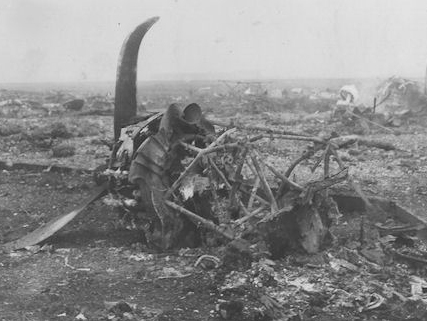

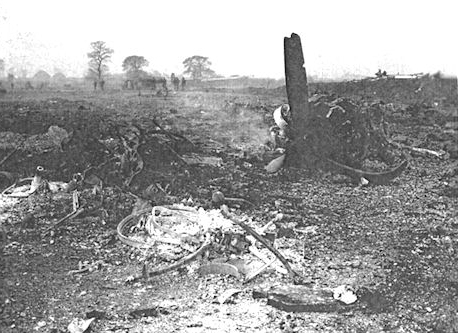
Eleven men from the 392nd BG were awarded the Soldier's Medal for their heroic actions during this incident. It is a non-combat award given to any person who, while serving in any capacity with the Army, displays heroism not involving actual conflict with an enemy. It is a highly respected sign of personal bravery usually indicating risk of life. The men were Sgt Lee A. Doolittle, 1/Lt Robert E. Fletcher, Cpl Richard A. Holevoet, Cpl Allen C. Jacobs, 1/Lt Wilbur H. Metz, Sgt Vernon L. Olson, 1/Lt Brooks Pendleton, PFC Emil J. Ribar, T/Sgt James W. Switzer, Sgt Jack L. Truesdell, and Tec5 Finney D. Voelkel.
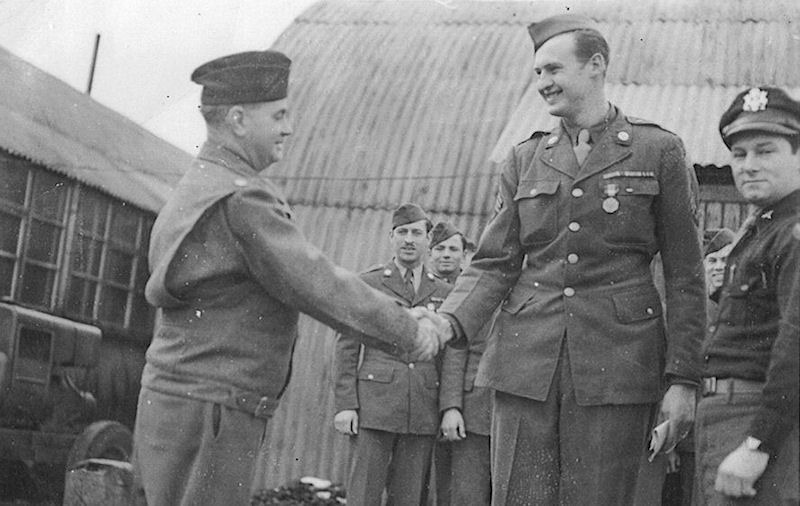


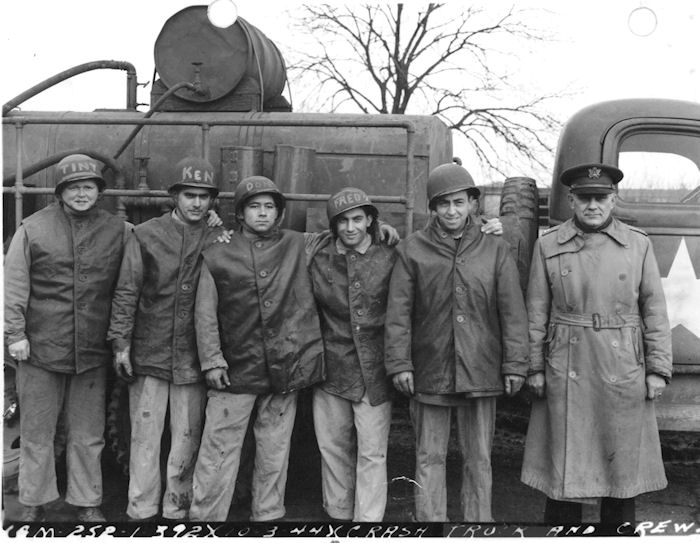
The photos below were provided by Ted Heinbuch, a historian of U.S. military fire fighting apparatus. For more information about the fire fighting trucks mentioned in the 2101st's history, see his website at www.firetrucks-atwar.com
.



